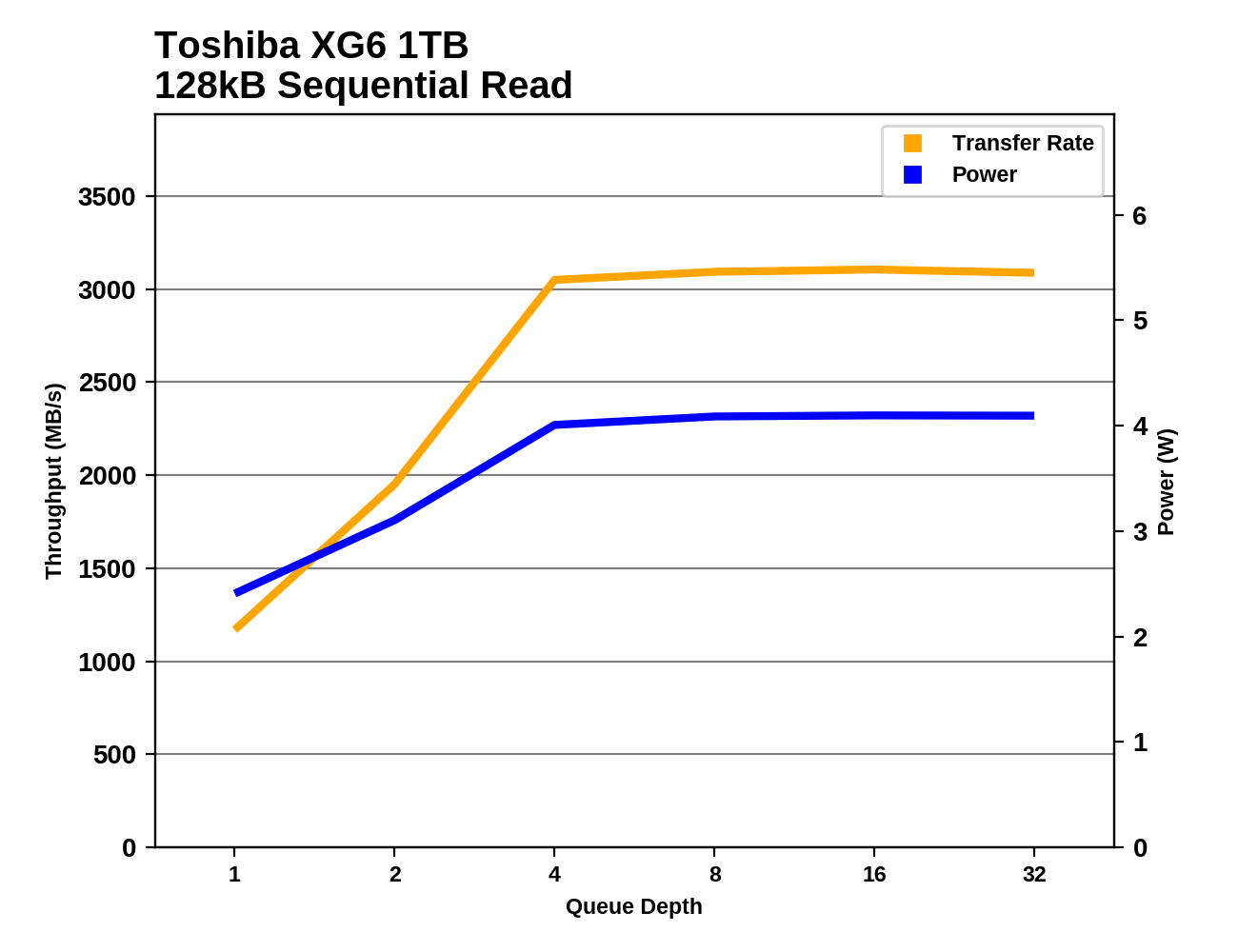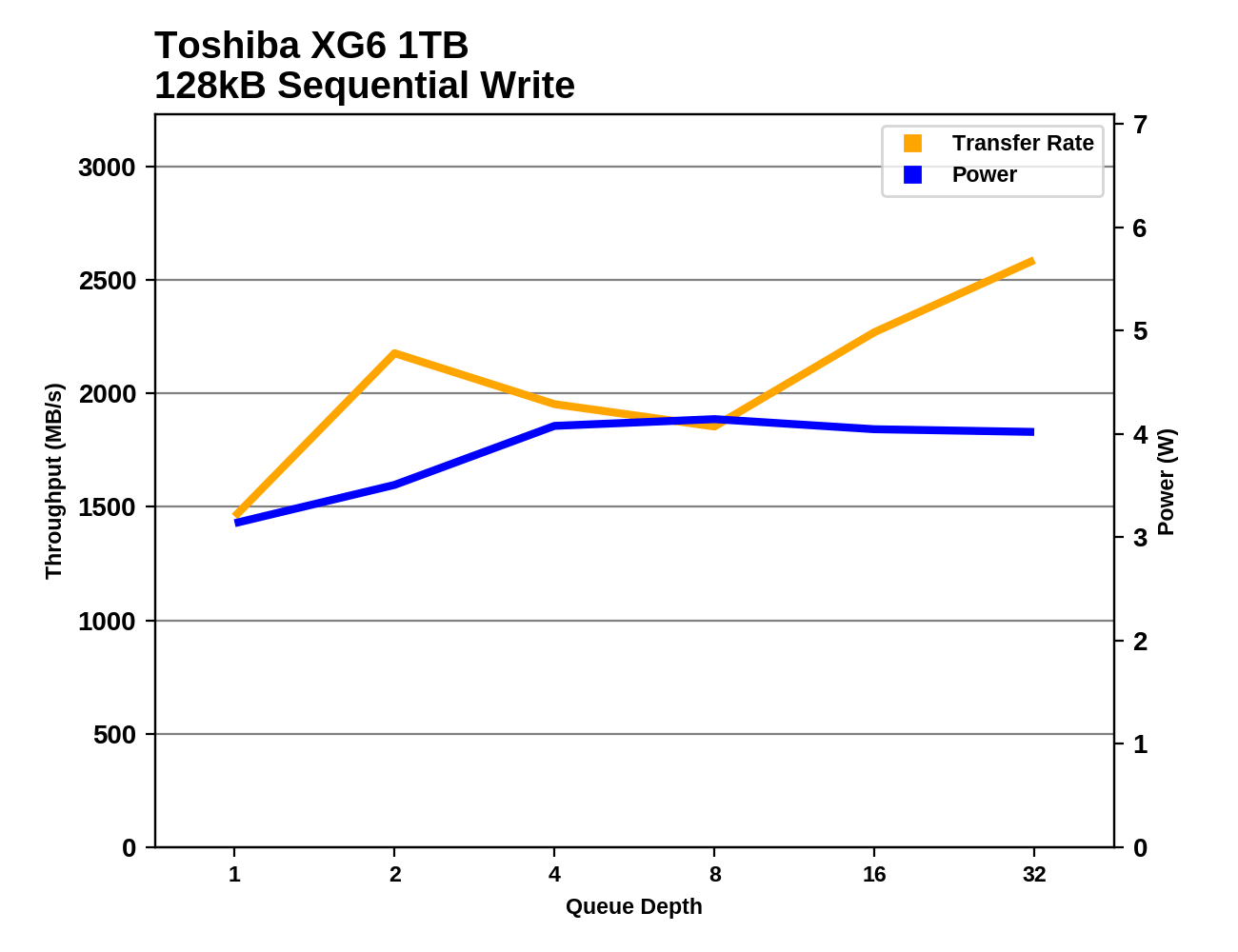The Toshiba XG6 1TB SSD Review: Our First 96-Layer 3D NAND SSD
by Billy Tallis on September 6, 2018 8:15 AM ESTSequential Read Performance
Our first test of sequential read performance uses short bursts of 128MB, issued as 128kB operations with no queuing. The test averages performance across eight bursts for a total of 1GB of data transferred from a drive containing 16GB of data. Between each burst the drive is given enough idle time to keep the overall duty cycle at 20%.

The burst sequential read speed of the Toshiba XG6 is slightly slower than the XG5, and still middle of the road for NVMe drives. The top drives are approaching twice the QD1 performance of the XG6, so this is probably where Toshiba needs to focus the most on improving.
Our test of sustained sequential reads uses queue depths from 1 to 32, with the performance and power scores computed as the average of QD1, QD2 and QD4. Each queue depth is tested for up to one minute or 32GB transferred, from a drive containing 64GB of data. This test is run twice: once with the drive prepared by sequentially writing the test data, and again after the random write test has mixed things up, causing fragmentation inside the SSD that isn't visible to the OS. These two scores represent the two extremes of how the drive would perform under real-world usage, where wear leveling and modifications to some existing data will create some internal fragmentation that degrades performance, but usually not to the extent shown here.

The longer sequential read test including moderately higher queue depths puts the XG6 in much better light, with clear improvement over the XG5 and scores that are behind only Samsung and Silicon Motion.
 |
|||||||||
| Power Efficiency in MB/s/W | Average Power in W | ||||||||
The power efficiency of the Toshiba XG6 during sequential reads is uncontested by anything other current drive using flash memory. It delivers 15% better performance per Watt than the SM2262EN that is tied for highest absolute performance.
 |
|||||||||
The Toshiba XG5 wasn't quite able to deliver its maximum sequential read speed at QD4, but the XG6 is saturated by then and delivers more than 3GB/s. The Silicon Motion controllers scale up in performance soonest, with the HP EX920 delivering full sequential read speed at QD2 while some high-end drives don't saturate until QD16.
Sequential Write Performance
Our test of sequential write burst performance is structured identically to the sequential read burst performance test save for the direction of the data transfer. Each burst writes 128MB as 128kB operations issued at QD1, for a total of 1GB of data written to a drive containing 16GB of data.

The burst sequential write speed of the Toshiba XG6 is another slight regression relative to the XG5, but it doesn't change its standing all that much. The Samsung 970 EVO and the upcoming high-end controllers from Silicon Motion and Phison offer substantially better QD1 performance, but the XG6 is more or less tied with most of the current high-end drives like the WD Black and the HP EX920.
Our test of sustained sequential writes is structured identically to our sustained sequential read test, save for the direction of the data transfers. Queue depths range from 1 to 32 and each queue depth is tested for up to one minute or 32GB, followed by up to one minute of idle time for the drive to cool off and perform garbage collection. The test is confined to a 64GB span of the drive.

The sustained sequential write speed of the Toshiba XG6 is a substantial improvement over the XG5 and puts the XG6 very close to the top of the charts with clearly better performance than any of the BiCS3-based drives.
 |
|||||||||
| Power Efficiency in MB/s/W | Average Power in W | ||||||||
The Toshiba XG5 was still holding on to its lead in power efficiency (among flash-based SSDs), and the XG6 runs up the score by another 5% by delivering much higher performance while still drawing less power than any competing high-end NVMe drive.
 |
|||||||||
The sequential write performance of the XG6 shows some variability due to the SLC cache filling up and requiring some background work that doesn't fit within the idle time this test provides, but performance doesn't drop as much or as often as for the Phison E12, and the average at higher queue depths is still competitive with the drives that offer steadier write speeds.










31 Comments
View All Comments
halcyon - Monday, September 10, 2018 - link
Sorry for the typos, mobile posting on the fly... Wish there was at least a 1min edit/fix window for new posts...